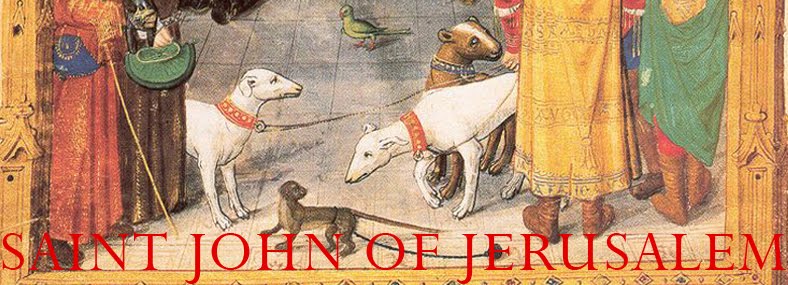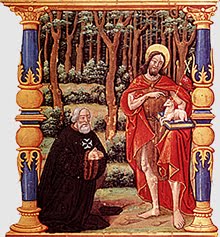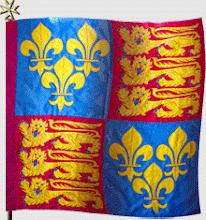ORATIODeus in te sperántium fortitude, adesto precibus nostris : quas tibi cum gratiarum offerimus actione : pro Victoria Magistro nostro, ac ejus exercitui, contra hostes Fidei Christanæ Turcos, per te mirabiliter Rhodi concessa : supliciter deprecantes: ut solitá tuæ pietatis clementiá muniti, dextráque tuæ potentiæ defensi : ab hostium infidiis, omníque adversitate protegámur. Per Dominum nostrum Jesum Filium tuum, qui tecum vivit et regnat in unitate Spiritus Sancti Deus, per omnia sæcula sæculorum. Amen.
SECRETAHostias tibi Domine placationis et laudis offerimus, suppliciter exorantes : ut qui nos de Fidei tuæ hostibus triumphare fecisti : clementer ab inimicorum infidiis, et omni periculo salves et munias. Per Dominum nostrum Jesum Filium tuum, qui vivit et regnat in unitate Spiritus Sancti Deus, per omnia sæcula sæculorum. Amen.
POSTCOMMUNIOSumptis redemptionis nostræ muneribus, quæsumus Omnipotens Deus : eorum celebratione tuæ protectionis auxilium : et famuli tui N. Hospitalis Hiersolomitani Magistrum, cum suo Exercitu, gratias de Triumphis Turcarum hostium fidei, nomini tuo sancto referentem : ab omni inimicorum incursu, cunctisque adversitatibus liberes semper et protegas. Per Dominum nostrum Jesum Filium tuum, qui tecum vivit et regnat in unitate Spiritus Sancti Deus, per omnia saecula sæculorum. Amen.
VICTORY OVER THE TURKS AT RHODES - FEAST OF SAINT PANTALEON
For those members of the Order who wish to celebrate the great naval victory over the Turks at the Siege of Rhodes by Grand Master Pierre d'Aubusson on this day in 1480, given below are the prayers to be added to the prayers of the day for the Mass and Office.
D'Aubusson, who was 57 at the time of the siege, was one of the most accomplished Grand Masters ever to lead the Order. A man of fine presence, a polished diplomat, a Cardinal, and as the siege was to show, a courageous leader in war.
The besieging Ottoman army was made up of 170 ships and 100,000 men, under the command of Gedik Ahmed Pasha. Grand Master d'Aubusson's small garrison was reinforced by 500 knights from France, and 2,000 soldiers under the command of the Grand Master's brother Antoine.
On this last decisive day of the battle, on which the Turks managed to capture the tower of the Langue of Italy, the battle rose to a frenzy during which 4,000 Turks were slain. The Hospitallers finally reached the tent of the Grand Vizier and captured the holy standard of Islam.
Defeated, the Ottoman fleet finally left on 27th August. Safety for Christian sea traffic in the Mediterranean was thus assured, until the fall of Rhodes in 1522.
For next year, it would be very kind if someone would furnish us with a good usable translation into English, this may be sent to "Blog Editor" via the BASMOM office, either by email or post.
The prayers were first published in a Missal in use in the Order's church of Saints John and Cordula in Cologne in 1659. Two years ago this Mass was celebrated solemnly at Pantasaph on the BASMOM Holywell Pilgrimage. Chaplains are encouraged to commemorate it in their daily Mass.
This day is celebrated in the Order as a First Class feast.
Category (click to see all related):
Catholic life,
Faith,
Saints of the Order
HOMILY FOR BLESSED DAVID GUNSON, M. ON
The Feast of our Martyr, 12th July, was marked by a small pilgrimage beginning with Mass at the Church of the Precious Blood Borough, and a walk past Marshalsea Gaol, then along the route of the martyrdom from King's Bench Gaol to St Thomas Waterings, on the Old Kent Road, along which Blessed David was dragged on a hurdle to be hanged, drawn and quartered on this day in 1541. St Thomas Waterings was the nearest execution site for the Southwark gaols, being just outside the City of London jurisdiction, as executions were forbidden within the boundaries. St Thomas Waterings was also the site of the Thomas-a-Becket inn, still extant, where Chaucer's Pilgrims drew the lots to decide the order of the Canterbury Tales, and which Blessed David would doubtless have known from happier times.
The Mass was celebrated by Father Gerard Skinner, a notable historian of the English Reformation saints. We are grateful to him for sending the text of his homily, which will be of interest both to devotees of our Martyr and to students of the Reformation. It is given in full below.
Blessed David Gunson, pray for us and for England.
Whether for priest or for layman, the bills were pretty much the same: “Paid to a Frenchman who took away the priest’s bowels after he had been hanged: 20s; for coals to make the fire: 6d; for a wright’s axe, to behead the priest: 4s. 6d; for a hand axe and a cutting knife, to rip and quarter him: 14d; and for the horse which dragged him from the hurdle to the gallows: 12d; for four iron brackets, with hooks on them, to hang the priest’s four quarters on the four gates of the city: 3s. 8d; for an iron wedge to break up wood to make a fire on the moor: 18d; and for a shovel for the fire: 2s; to a mason for two days’ work, securing the brackets to the gates: 10d per day; for carrying the four quarters of the priest from gate to gate, and other charges, 2s; for straw, candle, drink; and string to bind the priests’ arms before he was executed: 9d; . . .; for drink which another prisoner had before he executed the priest: 2d.” This is a list from the Newcastle Corporation Accounts. In such petty sums was the cost of a life calculated. In such sums, doubtless, would the close of the life of the martyr whom we revere today have been reckoned and recorded.
Category (click to see all related):
Reports,
Saints of the Order
HOLYWELL PILGRIMAGE
The Grand Priory and British Association's annual pilgrimage to Saint Winifride's Well at Holywell, North Wales, took place last weekend.
As ever, the weekend, well attended by some 30 pilgrims, was immaculately organised. The Saturday included a visit to the Dome of Home, New Brighton, in the Diocese of Shrewsbury.
This church has special relevance for members of the Order, as it is the home of Canon Scott Tanner, who before he went to Seminary at Gricigliano, had served the Easter Triduum in our Conventual Church in Saint John's Wood for two years. He remains a close friend of many.
This church has special relevance for members of the Order, as it is the home of Canon Scott Tanner, who before he went to Seminary at Gricigliano, had served the Easter Triduum in our Conventual Church in Saint John's Wood for two years. He remains a close friend of many.
The Mass at Holywell was particularly special this year, as instead of being in the Parish Church, it was celebrated in the mediaeval Shrine Church, in which there is no record of Catholic Mass ever having been celebrated since the dark days of the 16th century, though the Orthodox have apparently used it on various occasions. It is in the ownership of the State. We are grateful to CADW and to the Diocese of Wrexham for their permission and support.
The Shrine Church literally sits on top of the Well. That is to say that it is supported by the elaborate structure of columns and arches which surround the Well basin. It is most likely this structural fact which saved the well from destruction.
At the Reformation the church was desecrated, and the altar ripped out, though the walls and magnificent roof left intact. The mortar can barely have been dry, as it is very late Perpendicular in style. For our Mass it was necessary to erect an altar, containing a consecrated relic stone, and this process may be watched in this video.
The Well itself is the only pre-Reformation place of pilgrimage in Britain which has known no break in the public visit of pilgrims, and was indeed visited by King James II and his Catholic Queen Mary of Modena. The Order's pilgrimage, started by Sir Jeremy Mostyn, has been running for well over 30 years.
A special moment on the Pilgrimage this year was the 70th Birthday of our Chaplain Dr Antony Conlon on the Feast of Saint Toscana, Virgin of Our Order (in some dark places Bastille Day), Ad multos annos!
More photographs of the Mass may be seen HERE.
Saint Winifride, pray for us.
Saint Toscana, pray for us.
Category (click to see all related):
Catholic life,
Reports
PATRONAL FESTIVAL - Saturday 8th July
The Grand Priory will celebrate the Feast of its Patron, Blessed Adrian Fortescue, Martyr, this Saturday with Holy Mass at 11am at St James’s Spanish Place, W1U 3QY. The celebrant will be Father Hugh Allan, OPraem, Titular Abbot of Beeleigh, Prior of the Norbertine Priory at Chelmsford.
All members of the Order, Companions and friends are welcome to join in this celebration. A reception will follow the Mass.
Category (click to see all related):
Notices of Future Events,
Saints of the Order
1st JULY - SAINT NICASIUS, Martyr ON
Today, in addition to being the Feast of the Most Precious Blood of Our Lord, at least in some places, and of Saint Oliver Plunkett, (to whom many members and friends of the Order in Britain are related, and for whom we pray especially this day) is also the feast of Saint Nicasius, martyr of our Order.
 |
| The reliquary of the Saint in Caccamo |
Nicasius holds an honoured place in the Order's calendar by sharing his feast with the Octave Day of that of our holy Patron Saint John the Baptist.
He was born in Sicily in 1135. As a knight of the Order of Saint John, he fought as one of the defenders at the siege of Acre in Palestine and was captured and beheaded there in 1187 with many others, including, it is said, his brother Ferrandino.
There is popular belief about Nicasius still current in Sicily, and one hopes in our Order : under his effigy, drawn on a column of Saint Dominic of Palermo, can be read this inscription, "S. Nicasius Martyr et Miles Domini nostri Jesu Christi, multas in collo habuit glandulas et imperavit a Domino nostro Jesu Christo ut quicumque nomen suum supra se portaverit, glandulae ei nocere non poterint. Amen". Therefore, our Knight was either scrofulous or suffered from scrofula as a consequence of his tortures. He will guard us from scrofula from his high place in heaven, on one simple condition: if our 'glands' worry us or trouble our children, let us write with confidence the name of Saint Nicasius and let us wear it on us or put it in the clothing of the patient; the holy Martyr will indeed know how to cure the disease he knew.
On October 4, 1996 the Archbishop of Palermo, Cardinal Salvatore De Giorgi issued a decree to reactivate the ancient Confraternity of Saint Nicasius. The Martyrologium Romanum promulgated in 2001 by Saint John Paul II set the liturgical festivities of Saint Nicasius Martyr to the July 1 “Die 1 iulii – Ptolemaide in Palestina, sancti Nicasii, equitis Ordinis Sancti Ioannis Hiresolymitani et martyris, qui in terrae Sanctae defensione a Saracenis captus et decollatus est”. (July 1, Ptolomaides, in Palestine, to Saint Nicasius martyr, knight of the Order of Saint John of Jerusalem, who in the defense of the Holy Land was captured and decapitated by the Saracens). In Caccamo, every year, besides the liturgical festival on July 1, the transfer of the relic of Saint Nicasius is celebrated on the last Sunday of August and the following Monday.
Collect : O God, every year you give us joy in the commemoration of your martyr, blessed Nicasius: grant that through his prayers and example the companions of our Order may grow in faith and always follow you with all their hearts. Through our Lord Jesus Christ your Son who lives and reigns with you and the Holy Spirit, one God, for ever and ever. Amen.
Category (click to see all related):
Saints of the Order
Subscribe to:
Posts (Atom)



















